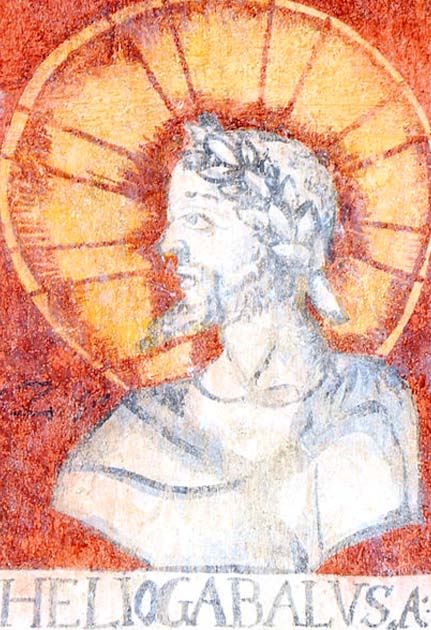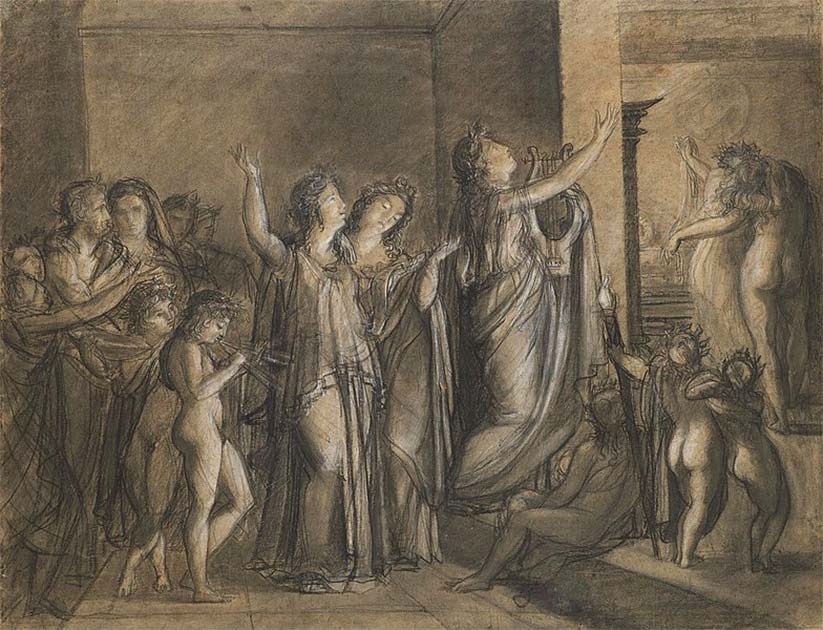Roman history is full of mad, bad, and completely off-the-wall bonkers emperors. Even so, the reign of Emperor Elagabalus stands out as one of the most unconventional and controversial Roman periods.
From 218 to 222 AD, Sextus Varius Avitus Bassianus, better known as Elagabalus, took the throne, leaving a very nasty taste in his empire’s mouth. Despite only ruling for four years, he has gone down in history for his religious and sexual experiments, his lavish and bizarre parties, and his violent death at the hands of his own soldiers.
More recently he’s found renewed fame as “Rome’s first transgender Emperor” in pop culture, a somewhat oversimplified conclusion which has predictably leading to more controversy. Let’s try to separate fact from fiction to discover what really made him such a controversial ruler.
Who was Emperor Elagabalus?
Elagabalus was born in either 203 or 204 AD to Sextus Varius Marcellus and Julia Soaemias Bassiana. Born into the Severan dynasty, he hailed from Emesa, a city in the Roman province of Syria. His father was an equestrian (a high social class) who later became a senator while his mother was cousin to the emperor, Caracalla (who rumor had it was really Elagabalus’s father).
Historically Elagabalus’s family held the hereditary rights to the priesthood of the local sun god, Elagabal. From an early age, Elagabalus had a strong connection to this deity, and his given name, Varius Avitus Bassianus, became overshadowed by the epithet “Elagabalus,” derived from the Syrian sun god which he gave himself.
Elagabalus became the high priest of Emesa as a child, but fate had even bigger things in store for him. When he was just fourteen Caracalla was assassinated and emperor Macrinus came to power. His first act was to exile the family of his predecessor, including Elagabalus, his parents, and his grandmother, Julia Maesa.

This was a wise choice; Julia Maesa wanted her grandson on the throne. Alongside her his tutor, Gann, she exploited the volatile political climate to secure Elagabalus the allegiance of Third Legion at Raphana.
Led by Gannys, this legion defeated Macrinus at the Battle of Antioch on 8 June 218 AD. Soon after Elagabalus wrote to the senate declaring himself emperor, claiming to be Caracalla’s son. It seemed no-one had the energy left to argue and so Elagabalus was emperor.
A controversial start for sure but Elagabalus wasn’t the first, or last, emperor to seize power for himself. So why is he seen as so strange? Well, what really set Elagabalus apart was his audacious attempt to reshape the religious landscape of the Roman Empire.
He was obsessed with the god Elagabal and made it his short life’s mission to elevate the cult of Elagabal and make this relatively obscure god the Roman religion’s primary deity. This was a major departure from traditional Roman worship and didn’t win him much support. This drastic shift encountered fierce resistance from both the Roman Senate and the general populace, who were accustomed to the established pantheon.
Elagabalus’s dedication to the sun god went beyond theological reforms. He transported a black conical meteorite, believed to represent Elagabal, to Rome and installed it as the central object of veneration. This move not only symbolized his commitment to the new faith but also highlighted his willingness to challenge deeply ingrained Roman religious traditions.
Beyond his religious pursuits, Elagabalus’s personal life further fueled the unusual nature of his rule. Notorious for his marital escapades, he married and divorced multiple times, engaging in relationships that scandalized Roman society. Divorce was highly frowned upon at the best of times and could be political suicide, but the people Elagabalus chose to be his spouses in the first place made things that much worse: two men and a sacred virgin.
Much like other controversial emperors, Elagabalus liked to party. The emperor’s penchant for extravagant and debauched festivities added to the growing discontent among the Roman elite.
Elagabalus reveled in lavish displays of wealth and opulence, contrasting sharply with the frugality expected of a Roman ruler. His flamboyant lifestyle, coupled with his unconventional religious reforms, created a rift between the emperor and the traditionalists who clung to the old ways.
Story Time
We have to be careful which stories surrounding Elagabalus’s life we take as fact but even so one thing is clear, his countrymen found his sex life both fascinating and deeply problematic. One classical historian, Cassius Dio, recorded how the emperor liked to put on makeup, shave all his body hair, and wear wigs so that he could work as a prostitute in Rome’s bars and brothels.
It was also claimed that the emperor had a special room in his palace just for orgies. Apparently, Elagabalus would stand stark naked in the entrance, inviting in passers-by who had been pre-approved by his aides on the condition that they call the emperor “mistress” and treat him as such.
Such behavior does suggest that Elagabalus was transgender, but this conclusion is overly simplistic, and falls into the trap of assuming modern social and sexual norms also applied to the Romans. In truth, many Roman Emperors, all-powerful deified rulers of vast territories, came to experience personal freedoms which were not available to their subjects.
Indeed, this behavior only became problematic to those around him once Elagabalus developed a habit of awarding senatorial and military positions to the male lovers he met at these orgies. It’s said that one male “dancer” was made Prefecture of the Guards while Gordius, a charioteer the emperor became fond of, was made Prefect of the Watch. These were military roles given to people who had no idea how to perform them.
Another story tells how he made a local baker head of the city’s grain supply. Supposedly, the bigger his lover’s genitals, the better the reward: hardly a way to run an empire.
These rumors of the emperor’s sexual escapades and indulgence in lavish banquets where guests were showered with petals and perfumes added fuel to the fire of public discontent. In fact, the rumors only got more extreme.
One story, “The Roses of Heliogabalus” tells how during his orgies he liked to smother his dinner guests to death by dropping masses of flowers from the ceiling. As can be seen, the Emperor felt he could act with impunity.
- Castrato: The Voice of an Angel, But At What Cost?
- Mausoleum of Augustus: Why Are There No Tombs of Early Roman Emperors?
Then there was the time he married a Vestal Virgin, Julia Aquilia Severa, one of the most shocking episodes of Elagabalus’s reign. This union not only violated sacred vows but also incited anger among the Roman people, who viewed it as a sacrilege. The relationship did not last long, as Elagabalus eventually divorced Severa, adding another layer of scandal to his tumultuous personal life.

Amazingly, this wasn’t the marriage which caused the most outrage. The record also shows that he married a chariot driver called Hierocles, a blonde slave from southwestern Anatolia.
According to contemporary historians, Elagabalus referred to the charioteer as his husband and called himself Hierocles’s “wife” and “queen.” Hierocles wasn’t even his only husband. Some stories recount how he also married Oticus, a male athlete from Turkey.
It’s easy to sense a bit of a theme here. If these stories are to be believed the teenage emperor certainly does seem to be transgender, and there are other points to back this up.
It was reported that he offered a vast fortune to any doctor willing to change his birth sex via surgery. In recent years this had led Elagabalus to be known as one of Rome’s first gender-fluid rulers, and that he could perhaps have been transgender, shining a more sympathetic light on his rule.
Still a Tyrant, Though
While some accounts depict him as a tyrant who loved excess, others suggest that Elagabalus may have been a victim of biased historical narratives, with detractors exaggerating or fabricating stories to tarnish his legacy. Much of the information about his reign comes from biased sources, often written by those who opposed him. The political turbulence of the time further complicates the task of discerning reality from propaganda.
While some accounts of Elagabalus’s excesses may be exaggerated, there is evidence supporting certain aspects of his unconventional behavior. The marriage to Julia Aquilia Severa, for instance, is documented in historical records, although the motivations behind such a controversial union remain a subject of speculation.
Likewise, the installation of the Elagabal cult and the transportation of the sacred meteorite are also well-documented events, signifying the emperor’s commitment to religious reform. Emperors creating their own cults hardly started with Elagabalus, however.
Today, Elagabalus’s legacy is a difficult one. It’s hard to parse fact from fiction, especially when it comes to theories surrounding his gender. Was he a mad ruler, or was he persecuted for being himself?
Either way, the fact he was a deeply controversial ruler can’t be denied. That’s why, in the end, his grandmother had the Praetorian Guard execute him and drag his naked body through Rome’s streets before throwing his headless corpse in the River Tiber.
A terrible end for a troubled emperor.
Top Image: Bust of Elagabalus. Source: © José Luiz Bernardes Ribeiro / CC BY-SA 4.0.